|
























| |

SEA VIXEN
All visitors with an interest in the Sea Vixen
should visit Martyn Dean's excellent site, the address of which is in our
favourite links page. It may also be accessed by clicking
HERE.
From the November 2004 issue
Back to index
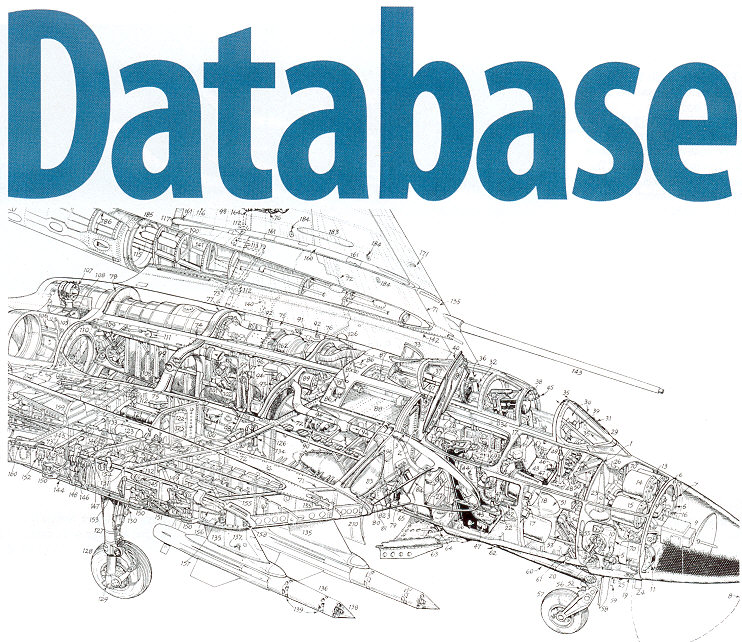
De
Havilland Sea Vixen
De
Havilland's mighty Sea Vixen was the first British
aircraft to be designed as an integrated weapons system,
and the Fleet Air
Arm's first swept-wing all-weather fighter. Despite a
tragic � and very public � accident to its predecessor,
the D.H.110,the type completed a highly successful
career. TONY BUTTLER traces the development of
the radical twin-boomer.
|
|
"On
February 20,1952,WG236 was taken beyond Mach 1,
becoming the first operational-type aircraft, the
first two-seater and the first twin-engined aircraft
to break the 'sound barrier'" |
T
HE
ROYAL NAVY'S (RN) post-war quest for a radar-equipped
all-weather fighter was a long-drawn-out affair. A new
Naval Staff Requirement, NR/A.14, and Specification
N.40/46 were issued for proposals in January 1947,
calling for a twin-jet naval nightfighter to replace the
de Havilland Sea Hornet piston fighter, with a top speed
of at least 500kt from sea level to 20,000ft and a
maximum all-up-weight of 30,000lb. The highest possible

|
manoeuvrability was requested, and it had to be able to
land and take off from carriers by day or night.
Proposals were received from Blackburn, de Havilland,
Fairey, Gloster and Westland.
De
Havilland's project, given the type number D.H.110, was
a variant of a design first submitted in March 1947 in
response to RAF nightfighter specification F.44/46. The
RAF D.H.110 had two 7,000lb-thrust
Metropolitan-Vickers F.9 engines (later the Armstrong
Siddeley

|
Sapphire), four cannon and airborne interception (Al) Mk
9D radar. Its span was 49ft 6in, length 47ft 11 in,
gross wing area 640ft. all-up-weight 26,3501b and
estimated top speed 570kt (Mach 0-86) at sea level and
543kt (Mach 0-90) at 25,000ft, The D.H.110 was
eventually selected as the winner of the RAF
requirement, but a Gloster design was also accepted,
later becoming the Javelin (see Database, January
2003 Aeroplane). Three RAF D.H.110s were planned,
but by

(continued
below left column)
|
ABOVE
Arthur Bowbeer's magnificent cutaway illustration of the
Sea Vixen from the February 5, 1960, issue of Flight.
|
|
|
|
|
|
|
|
|
|
|
|
|
|
January 1948 the armament and radar requirements
were under drastic review; F.44/46 was replaced by
F.4/48, and by July the Rolls-Royce
Avon had become the D.H.110's lead engine.
The RAF and
RND.H.110s were
essentially
the same apart from specific naval equipment and
some alterations made during 1947. The
navalised
D.H.110 was proposed in
September
with a swept-forward tail
surface
expected to be better
structurally
and aerodynamically than
the RAF
version's "straight tail". The
two crew were
seated side-by-side and slightly staggered, and four
20mm
Hispano cannon were housed
under the
cabin floor. De Havilland's
Vampire and
D.H.108 experience had
led to the
conclusion that wing
sweep was
essential to achieve the Mach 0-87 required by the
RAF nightfighter, so a sweep angle of 40� at the
quarter chord would easily cover the Mach 0-82
requirement
in N.40/46.
An
N.40/46 Design Study
|
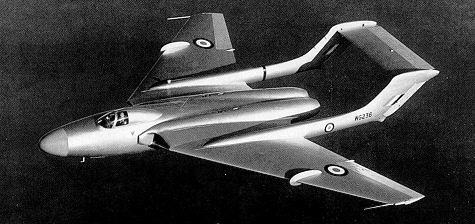 |
|
|
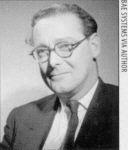 |
ABOVE The first D.H.110
prototype, WG236, which
made its
maiden 46min flight at Hatfield in the
hands of
John Cunningham on September 26,1951,
and which
threw the whole D.H.110 programme
into jeopardy
after its fatal crash at Farnborough
the following year.
LEFT Designer J.P. "Phil" Smith,
responsible for the Sea Vixen at Hatfield until its
move to Christchurch. He was also co-designer of the
pre-war Moth Minor.
|
public during the following month. The observer was
now housed inside the fuselage, with just a small
window to look through. At this time the screens for
the new airborne radars needed dark conditions for
ideal viewing, which sentenced the operator to a
world devoid of much light and also resulted in an
offset canopy for the pilot.
|
|
|
Conference held on December 15, 1947, agreed that
further investigation of the D.H.110 and Fairey's
designs should continue. After F.44/46 was updated
to F.4/48 in June 1948 the three D.H.110
nightfighter prototypes were ordered, together with
four examples of Gloster's design. Then, on January
3. 1949, it was proposed to acquire four more F.4/48
D.H. 110s for a
common RAF/RN
development programme on armament, radar and
instrument clearance, and two each to N.40/46,
F.5/49 (for an RAF long-range fighter) and N.8/49
(for a naval strike aircraft), bringing the total to
13 prototypes. In March the NR/A.14 requirement was
brought up to date under a new specification,
N.14/49. Four months later three naval D.H.110s were
ordered (two nightfighters, one strike), leading to
concern over the financial implications of procuring
so many prototypes. A joint trials programme for the
RN and RAF was agreed, but in November 1949 the
naval D. H.
110s were dropped for economy, leaving
N.14/49 to Fairey's project. The twin-boom design
seemed a logical advance over its ancestors, the
Vampire and Venom, both of which were conventional
aeroplanes in which the twin booms carried the tail
rather than having it fitted to the end of the
fuselage, thus permitting a very short and efficient
jetpipe. In

|
|
Neither D.H.110 received any
radar or armament. The first had 6,500lb-thrust Avon
RA.3s, while WG240 had 7,500lb RA.7s, intended to be
typical of the Service version but without reheat.
Initial test flying with WG236 revealed flight
characteristics that were much more pleasant than
had been experienced in the D.H.108. There was none
of the ghastly high-speed pitching oscillation that
had made the D.H.108 such a horror; the biggest
problem was found to be "snaking" at high speeds,
which was traced to aeroelasticity (flexing) in the
twin booms. As a result WG236 had its fin area
increased, and the tail-booms were stiffened with
steel reinforcing strips riveted on to the outside
surfaces. The curved fin extensions were faired into
the line of the rudder trailing edge under the rear
of the booms to give extra stability (WG240 had
modified booms of thicker-gauge aluminium alloy).
On
February 20, 1952,WG236 was taken beyond Mach 1 for
the first time, in a dive, by John Derry and Tony
Richards. It thus became the first operational-type
aircraft, the first two-seater and the first twin-engined
aircraft to break the "sound barrier". During 1952
it was decided to develop and fit a fully-powered
all-moving tailplane to provide good transonic
handling. There was no known practical method of
moving a

|
|
|
ABOVE
A sketch of the original D.H.110 concept, designed
to RAF nightfigher Specification F.44/46, with
side-by-side seating and unusual forward-swept tail
surface, both of which would be changed for the
prototype D.H.I 10s.
|
|
|
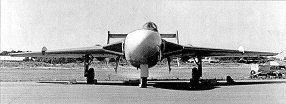 |
|
|
ABOVE
The second D.H.110 prototype,
WG240, at the SBAC show at Farnborough in 1953.This
head-on view illustrates well the distinctive
offsetting of the canopy to port, which remained on
the later Sea Vixen
|
|
|
comparison, the D.H.110's swept wing was similar to
that of the tailless D.H.108 research aircraft,
while the tail was set high and much closer to the
wing. The tail had to be added to counteract several
problems suffered by tailless aeroplanes (as
distinct from deltas), particularly a gradual loss
in longitudinal stability as the speed dropped.
Designer J.P. "Phil" Smith led the D.H.110 project
until it was transferred from Hatfield to
Christchurch.
After the naval machines were cancelled the
surviving RAF order

|
comprised five F.4/48 nightfighters
(WG236,
WG240, WG247, WG249 and WG252). The contract
for these machines was dated May 26,1950, but WG247
(to be Sapphire-powered),
WG249 and WG252 were all cancelled on June
14,1952. The surviving two were built in the
experimental shop at Hatfield, and WG236's taxying
trials began on September 16,1951. On September 26
chief test pilot John Cunningham made the first
flight, with Tony Fairbrother as his observer, and
the new fighter was first revealed to the

|
|
|
|
|
|
|
|
|
|
|
|
|
|
|
|
|
|
|
|
|
|
 |
|
|
|
|
|
|
"The
Farnborough crash was a great tragedy, but should
never be allowed to cloud the fact that the three
D.H.110s proved to be fine flying machines, and
valuable research tools for the Sea Vixen"
|
|
|
|
|
|
"slab tail" manually owing to
the very high loads involved, so any failure of the
hydraulic system had to be safe�guarded against by
full duplication and partial triplication. In 1954
the manual rudders were changed for fully-powered
alternatives using the same system duplication. It
was then found that many of the troubles associated
with yaw autostabilisation on manually-operated
controls were now eliminated and the rudder power
was greatly increased due to the removal of the
large balance tabs. Development of the D.H.110 with
fully-powered controls was largely completed by the
end of 1955.
On July 25,1952, WG236 was
followed into the air by WG240, and the extra power
available to the second aircraft was impressive. It
was also lighter than WG236, so WG240 was selected
as the flying display aircraft for the September
1952 SBAC show at Farnborough. It flew throughout
the week, but on the Saturday went unserviceable
owing to engine problems. John Derry and Tony
Richards went to Hatfield to collect WG236 as a
substitute, and flew this aircraft direct to
Farn�borough for their display. During a manoeuvre
WG236 broke up in the air, killing both crew, and an
engine landed in the crowd, killing another 27
people and injuring 63. The inquiry into this
accident was extensive. The flight had included a
supersonic dive from 40,000ft, with the pull-out
close to the airfield. After a fast pass, Derry
turned to port and made a tight left-hand circuit at
low
(Continued RH column)

|
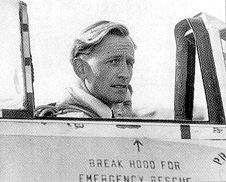 |
ABOVE
The second prototype in 1952 in its striking
all-black colour scheme, which made quite an
impression on the public during its dynamic
displays.
LEFT
John Derry in the cockpit of Vampire W218, which he
demon�strated masterfully at the SBAC show in 1948.
At the time of his death he was D.H. chief test
pilot.
|
level. While straightening out
from this turn about 1.5 miles north-west of the
public enclosure, WG236 disintegrated.
A film taken by a spectator
revealed what had happened. As WG236 banked to the
left towards the crowd its starboard outer wing
detached, immediately followed by the port outer
wing. With only the inner wing sections left, the
rapid nose-up change of trim following the wing
failures caused the cockpit, engines and tail to
detach in secondary failures under an abnormal g
loading. All of this occurred within about a second.
It was found that WG236 had succumbed to the
twisting forces produced while undertaking a
manoeuvre that combined a turn and a climb. The
accident report, dated April 8,1953, stated that the
cause was a combined effect of pull-up acceleration
(associated with turning) and the loads produced by
upward aileron (appropriate to straightening out
from a turn), which had created instability in the
structure. The D.H.110's wing form was the
problem. The
unusual D-nose leading-edge arrangement had
proved fine for the lightweight Vampire and Venom
but could not cope with the heavier stresses
experienced with the much bigger D.H.110.
Before WG240 flew again, in
June 1953, its wing structure was substantially
redesigned. It was fitted with a front spar web and
thicker wing ribs, while the inter-spar stringers
between ribs eight and
(contd. below left)

|
|
|
|
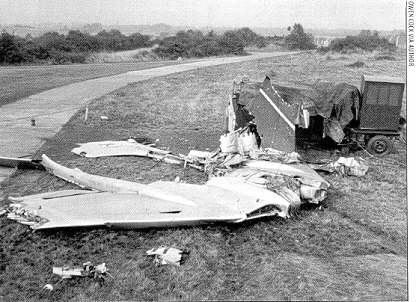 |
|
|
ABOVE
The awful aftermath of the
crash of WG236 on September 6, 1952.The subsequent
crash report determined that the joint actions of
torsion, shear and bending loads on the starboard
outer wing caused it to twist off, initiating
catastrophic failure of the entire airframe.
RIGHT Test pilots John
Cunningham (left), who made the D.H.I 10's first
flight, and "Jock" Elliot, who flew the maiden
flight of the navalised XF828.
|
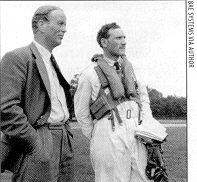 |
|
|
|
|
|
|
|
|
|
|
|
|
|
|
|
|
|
|
|
|
|
|
|
seven
were reinforced (all of these modifications were
retained on the Sea Vixen). Early in 1954WG240 was taken
in hand to receive the all-moving "flying" tail instead
of the original fixed tailplane and hinged elevator (at
the time it was the only British aircraft so equipped).
The powered rudders, plus cambered "droop-snoot" leading
edges on the outer wings and improved aileron controls,
were also fitted, and it made its first flight in this
form on June 11.
After
the loss of WG236, Gloster's Javelin nightfighter had
become the favoured candidate for the RAF requirement
and was eventually ordered in quantity. The RN's N.
14/49 requirement was withdrawn on July 19,1950, and
Fairey's project was abandoned. A new specification,
N.114T, was intended to replace it but, as a stop-gap,
the RN ordered a navalised de Havilland Venom (Sea
Venom) to fill the unacceptable gap between the Sea
Hornet and the new programme. In January 1952 each of
the tenders to N.114T was found to be unsuitable,
leaving the new all-weather fighter requirement
unfilled. R.E. Bishop at de Havilland designed an
improved Venom, the D.H.116 Super Venom, and a mock-up
was built, but Bishop informed the Admiralty that his
company could not cope with the project because of a
shortage of design staff. In November 1952 he suggested
a navalised D.H.110 as an alternative.
The
D.H.110 was assessed by the Ministry of Supply (MoS) on
March 5, 1953, to see how far a navalised version could
solve the navy's problems. There were doubts whether the
Al Mk 18 radar could be installed, even with a small
scanner, and the strength factors provided by D.H. were
on the bottom limit for fighter duties and would need
modifying for ground-attack operations. The Admiralty
also wanted four Blue Jay air-to-air missiles (AAMs).
The D.H.110 could be adapted to new requirement, NA.38,
and on July 14 the Naval Aircraft Design Committee
recorded formal acceptance of the type to this
specification.
The changes required to the

|
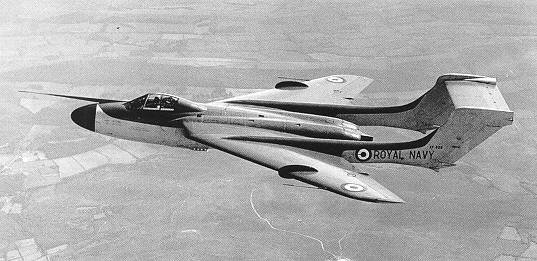 |
|
|
ABOVE
The third prototype,
XF828, was navalised but without folding
wings.
During August 1954 the
name Pirate was mooted for the type but was eventually
dropped, approval for Sea Vixen being made on March
5,1957.
|
sanction was delayed until December 31,1954, when
approval was given for 75 (later 78) aeroplanes.
The
Instruction to Proceed with the full programme arrived
in early January 1955, and the third prototype, the
navalised XF828, was first flown, from Christchurch, on
June 20 by "Jock" Elliot. Production aeroplanes were to
be designated FAW
Mk 20 (soon changed to FAW Mk 1. FAW � Fighter,
All Weather) and receive the Avon 208; the intermediate
XF828 was designated
FAW Mk 20X. Four
Blue Jay AAMs became the weapon choice, with the
Aden guns removed and replaced by packs of Microcell 2in
rockets.
On
September 23,1954, WG240 made a series of preliminary
approaches, overshoots and touch-and-go landings on the
deck of HMS Albion, with the intention of showing the
D.H.110's general handling to be adequate for carrier
operation. Its behaviour was reported as out�standing.
On April 5, 1956, XF828 made its first fully arrested
deck landing, on HMS Ark Royal. By early 1957 the
aircraft had received a large fixed in-flight refuelling
probe, and the first successful in-flight refuelling
with a tanker aircraft at 10,000ft was achieved on
January 10. The Farnborough crash was a great tragedy,
but should never be allowed to cloud the fact that the
three D.H.110s proved to be fine flying machines and
immensely valuable research tools for the
Sea Vixen.
|
|
|
|
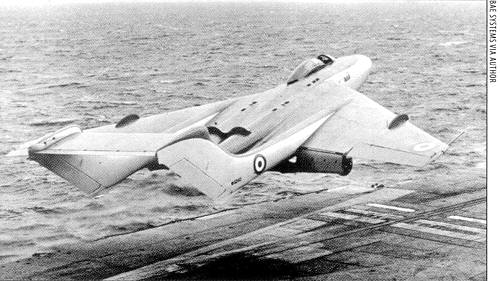 |
|
|
ABOVE In September 1954, Jock Elliot
made a series of touch-and-go landings
aboard HMS Albion with WG240 painted in naval colours
and fitted with
modified long-travel undercarriage oleos. The results
were very satisfactory.
|
|
|
existing D.H.110 were a folding wing, arrester gear and
other normal navalisation fittings, RA.14 Avons, the Al
Mk 18 radar, redesign of both main and nose
undercarriages, changes to the cockpit layout and
fitment of the all-moving tail and larger flaps.
Converting the RAF D.H.110 into a naval aircraft
required a lot of redesign, and most of the drawings had
to be changed. By now D.H.110 design work had been
transferred to Christchurch, and a new specification,
N.139D&P, was written around the aircraft. The standard
for the third prototype, to be constructed from spare
F.4/48 components to a contract dated November 6,1953,
was agreed in

|
August
1953. Specification N.139D&P stated that the D.H.110 was
to operate from HMS Hermes and larger-class carriers,
and its primary role was to be the destruction of enemy
reconnaissance and strike aircraft. Minimum top speed
was now set at 690 m.p.h. at sea level and 610 m.p.h. at
40,000ft, rate of climb at a minimum of 14,000ft/min
(later 18,000ft/min) and service ceiling at 48,000ft.
Production aircraft were to carry a mix of four Aden
cannon and two Blue Jay (Firestreak) AAMs or two Aden
and four Blue Jay.
An
initial approach to the Treasury was made in October
1953 for 100
machines. However, Treasury

|
|
|
The prototype D.H.110, WG236, spent its
brief life painted in a silver scheme with standard
roundels and a swept fin-flash.
Early trials with the first prototype showed the type to
be well in advance of a number of its contemporaries,
including the American Northrop F-89
Scorpion and Soviet MiG-17"Fresco"�
2004 JUANITA FRANZI
|
|
|
|
|
|
 |
|
|
|
|
|
|
|
|
|
|
|
|
|
|
|
|
|
|
|
| |
|
![]()
